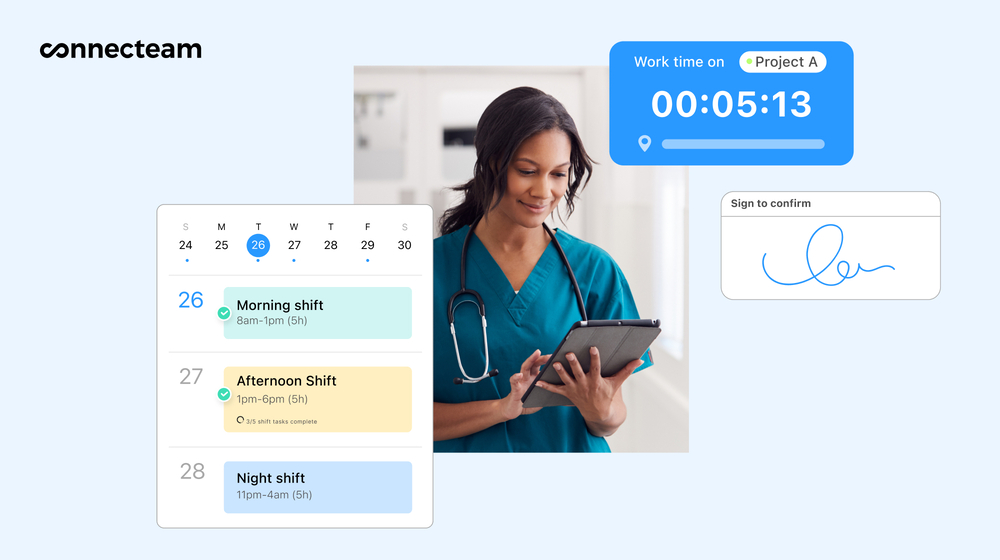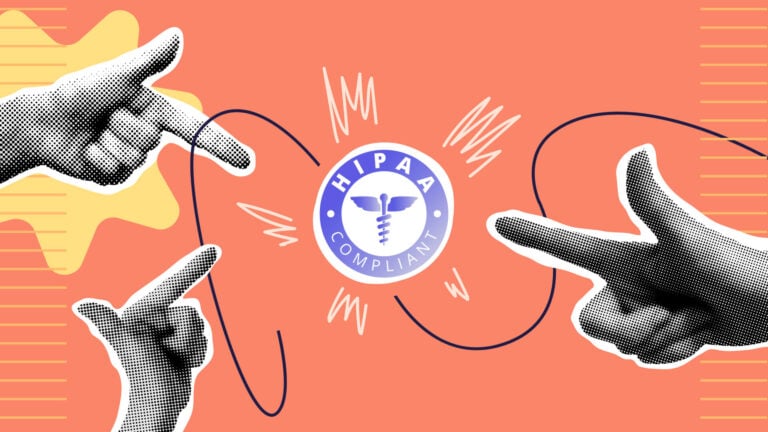By recognizing the signs, addressing the causes, and implementing practical solutions to healthcare workers’ burnout, we can foster a resilient healthcare workforce that continues to deliver exceptional care.
The unique challenges facing healthcare professionals – from high-pressure work conditions to emotional exhaustion – put them at a high risk for burnout.
As found in Mayo Clinic research, the direct link between burnout in healthcare workers and the quality of care, turnover, and reduced work effort has profound implications for the American medical and health system.
Taking appropriate measures to prevent healthcare worker burnout is vital to ensuring your team’s well-being, avoiding staffing shortages, and providing quality care.
To help you on your way, let’s explore signs of healthcare worker burnout, its underlying causes, and, most importantly, practical strategies to prevent it.
Noticing Healthcare Worker Burnout
Healthcare employers, supervisors, and managers must first know the signs of burnout in healthcare workers to support and accommodate them.
According to the World Health Organization (WHO), burnout is characterized by three dimensions:
- Feelings of exhaustion or energy depletion
- Intensified mental distance from one’s job, a sense of negativity, or work-related cynicism
- Decreased professional efficacy
While burnout in healthcare workers can manifest in different ways, it is often linked to symptoms, including a lack of energy, dreading going to work, feeling undervalued, and being continually overworked.
Did You Know?
Did you know that according to the American Psychological Association, healthcare professionals who have a supportive social network at work experience lower burnout rates?
Causes of Healthcare Worker Burnout
-
High-pressure work conditions
-
Lack of managerial support
-
Emotional exhaustion from patient care
According to the Agency for Healthcare Research and Quality (AHRQ), healthcare workers are at high risk of burnout due to their work environment’s “packed work days, demanding pace, time pressures, and emotional intensity.”
The COVID-19 pandemic has further exacerbated these challenges in the field of public health, intensifying the risk of burnout and intent to leave.
Insufficient time for patient care and the constant accessibility of physicians through smartphones and electronic medical records (ERMs) further contribute to the problem.
Working under such demanding working conditions, healthcare workers can quickly feel overwhelmed and worn out.
Overall, healthcare worker burnout arises when constant job stressors stay unaddressed by management.
Without proactive managerial support and open channels for staff to express their needs, receive guidance for growth and development, and gain encouragement, employees often feel isolated, uninformed, and unsupported.
Patient care is undeniably one of the most fulfilling aspects of working in healthcare, with professionals creating meaningful connections with patients and assisting their recovery.
However, healthcare professionals – from physicians to social workers to nursing assistants – can experience emotional exhaustion. Especially those working in critical or end-of-life care departments often face emotional disappointments of lower recovery and higher mortality rates.
Additional factors include managing non-compliant, drug-seeking, or threatening patients, as well as the number of patients per health worker, with each extra patient increasing the risk of staff burnout in healthcare by 23%.
This Might Interest You
For deeper insights into managing high-pressure work conditions, check out our in-depth article on how to spot, tackle, and prevent burnout.
How to Prevent Healthcare Worker Burnout
-
Offer scheduling flexibility
- Offering manageable work hours
- Allowing employees to swap shifts with qualified team members
- Granting sufficient time off
-
Make schedules predictable
- Notifying staff of their shifts well in advance
- Providing consistent work routines
- Taking work preferences into account.
-
Provide enough resting time
-
Manage workloads
-
Foster employee well-being and support
Balancing work and personal life can be particularly challenging in healthcare. So, acknowledging your team’s personal responsibilities and allowing time for self-care and family is key in preventing health care workers burnout.
You can support scheduling flexibility by:
Pro Tip
Implement ‘self-scheduling’ where possible. Allowing healthcare workers to have a say in their schedules can increase job satisfaction and reduce feelings of burnout. Connecteam’s employee scheduling feature allows for easy self-scheduling, giving employees control over their work-life balance.
Schedule predictability helps prevent healthcare worker burnout by providing them with the stability and foresight needed to manage work-life balance and reduce stress.
You can achieve this in multiple ways, such as:
Involving your team in the scheduling process further reduces schedule ‘surprises’ and makes it easier to prepare for what’s ahead.
Modern employee scheduling app is essential in achieving this goal, enabling you to quickly create, update, and publish schedules based on your team’s preferences.
This Might Interest You
Simplify scheduling and boost efficiency in your healthcare facility! Explore our guide to the best healthcare staff scheduling software to manage shifts, reduce conflicts, and ensure seamless operations. Find the perfect solution for your team today!
Sufficient time for rest and breaks is vital, particularly in healthcare settings with round-the-clock operations and extended shifts.
Ensure your team has adequate time for essential needs throughout their shifts, such as regular meals and brief moments to recharge, as well as sufficient time between shifts.
This offers valuable opportunities for mental and physical rejuvenation, contributing to the prevention of healthcare burnout.
The heavy workload and wide range of tasks healthcare workers handle daily are significant factors contributing to healthcare worker burnout. In fact, evidence-based research shows that handling excessive workloads doubles the chances of experiencing healthcare burnout.
So, if your team consistently takes on more than their fair share, take a look at their responsibilities and explore ways to distribute the workload more evenly among different teams.
Taking as little as 10% off your physicians’ task load already lowers the odds of burnout by 33%.
Furthermore, consider using a digital solution to simplify your team’s day-to-day and streamline processes, such as digitizing paperwork or a free task management software.
This Might Interest You
Simplify operations and enhance care delivery! Explore our guide to the best caregiver management software to efficiently manage schedules, improve communication, and ensure top-quality care. Find the right solution for your caregiving team today!
Taking a proactive approach by implementing an employee wellness program in your medical center can significantly nurture your staff’s physical and mental health and mitigate burnout.
Foster a work environment that values mental wellness by making it easy for your staff to access related resources and support, such as employee assistance programs (EAPs), individual or group therapy sessions, and on-site counseling services.
These initiatives help your health workforce deal with work-related pressures, show that you care about their well-being, and ensure they have the help they need when they need it.
Did You Know?
Regularly check in with your team about their mental health. Open communication can help identify burnout symptoms early and provide support when needed. Connecteam’s employee communication app enables managers to easily conduct regular check-ins and foster a supportive work environment.
Combatting Healthcare Worker Burnout with Connecteam
Leveraging a digital solution can make a huge difference in preventing staff burnout in healthcare.
Here’s a glimpse at how Connecteam’s employee management app does it.
HIPAA compliant
Connecteam is HIPAA compliant, so once you sign a business associate agreement (BAA), you can discuss personal health information directly within the app and upload patient documents for safe, secure, and convenient storage.
Optimize scheduling
- Flexibility: Quickly create optimal work schedules based on your team’s submitted availability, work preferences, and qualifications.
- Accessibility: Once ready, simply publish schedules for your team to access right from their mobile phones.
- Compliance: Avoid scheduling mishaps, like unwanted overtime or insufficient resting time between shifts, with inconsistency flagging and custom limitations.

Simplify your day-to-day
- Tasks: Easily delegate, track progress, and communicate with your team on daily tasks.
- Paperwork: Digitize time-consuming paperwork with digital forms for your team to complete on the job.
- Collaboration: Instantly communicate throughout the workday, see how everyone’s doing, and solve issues as they arise.
Promote employee well-being
- Programs: Manage wellness events for your teams – from mindset seminars to health care burnout awareness training.
- Resources: Make resources on wellbeing and coping with staff burnout in healthcare readily available to your team.
Bottom Line on Preventing Healthcare Worker Burnout
In the relentless effort to provide quality healthcare, the health and well-being of those on the front lines is a top priority.
By recognizing the signs, addressing the causes, and implementing practical solutions to healthcare workers’ burnout, we can foster a resilient healthcare workforce that continues to deliver exceptional care.
With Connecteam’s comprehensive employee management app, you have a powerful ally in this mission. Together, we can ensure that your team receives the support they deserve as they dedicate themselves to healing and caring for others.
If you read so far you might also be interested in reading our review of the best nursing home management software that will help you manage your nursing business




